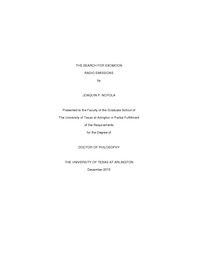| dc.description.abstract | The field of exoplanet detection has seen many new developments since the discovery of the first exoplanet. Observational surveys by the NASA Kepler Mission and several other instrument have led to the confirmation of over 1900 exoplanets, and several thousands of exoplanet potential candidates. All this progress, however, has yet to provide the first confirmed exomoon. Since all previous attempts to discover exomoons have failed, a novel method to detect them is proposed in this dissertation, which describes development of the method and its applications to select the best exomoon candidates for observational searches. The main goal of these searches is to verify the validity and effectiveness of the method, and discover the first exomoon by using the world largest and most suitable radio telescopes. The discovery of first exomoon would begin a new era of exploratory research in exoplanetary systems.
The idea that exomoons can be discovered with radio telescopes was proposed by Noyola, Satyal and Musielak et al. (2014), who suggested that the interaction between Io and the Jovian magnetosphere could also be found in exoplanet-exomoon pairs, and the resulting radio emissions could be used to directly detect these systems. The main results of the original study obtained for single prograde exomoons are also described in this dissertation, which in addition extends the previous study to multiple exomoon systems, as well as retrograde orbits. The main objective of these studies is to identify the best exomoon candidates for detection by chosen radio telescopes. One such candidates, Epsilon Eridani b, was selected and observed by the Giant Metre Radio Telescope (GMRT) in India. The preliminary results of these observations do not show any expected radio emission from the chosen systems. Thus, implementation of several important improvements to the method is discussed in details in this dissertation. | |

